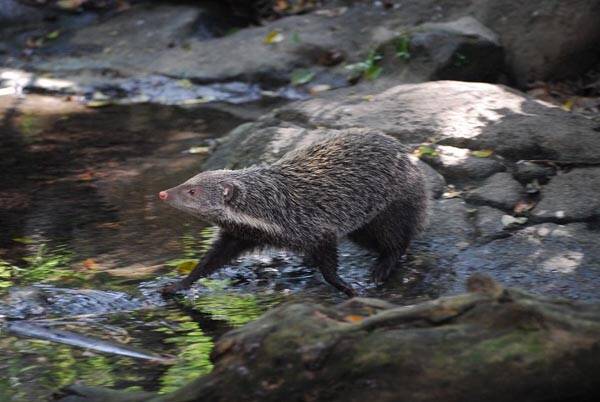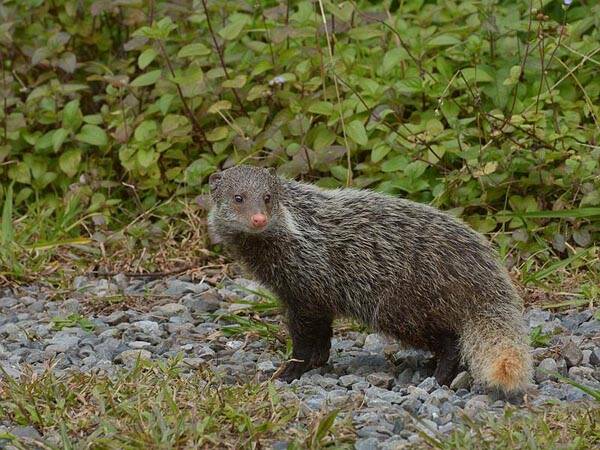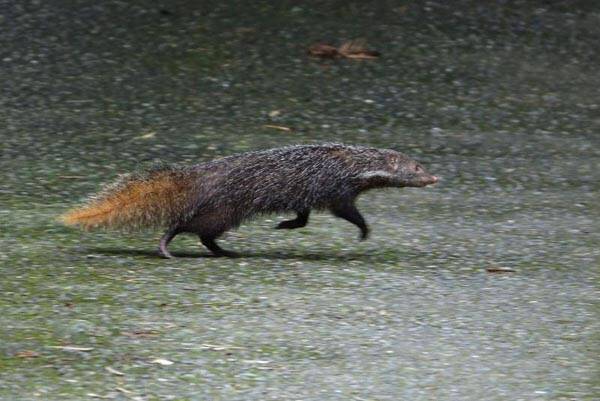Herpestes urva
IUCN
LCBasic Information
Scientific classification
- name:Herpestes urva
- Scientific Name:Herpestes urva,Crab-eating Mongoose,Mountain badger, brown cat, rock badger
- Outline:Carnivora
- Family:Meerkat
Vital signs
- length:40-84cm
- Weight:1.5-3kg
- lifetime:About 12 years
Feature
It is slightly larger than the red-cheeked mongoose, with thick and long fur, especially on the tail.
Distribution and Habitat
The world is distributed in China, Bangladesh, Assam in northwest India, Laos, Malaysia, Myanmar, Nepal, Bhutan, Thailand, Vietnam and other countries.
In China, it is distributed in Sichuan Province, Fujian Province, Guangdong Province, Hunan Province, Zhejiang Province, Guizhou Province, Taiwan Province, Jiangxi Province, Hainan Province, Anhui Province, Jiangxi Province, Hubei Province, Guangxi Zhuang Autonomous Region, Yunnan Province, Jiangsu Province, and Hong Kong.
Crab-eating mongooses generally live in woods, grass, mounds, stone crevices, and earth holes below 1,000 meters above sea level, and like to live in groups. They like to live in dense forests on both sides of mountain valleys and streams, especially in mountainous mixed woodland areas with mountain pits and fields, which are good environments for their frequent activities. They live in caves, and the cave structure is relatively simple. They often use tree holes, rock caves or haystacks as nests. They can climb
Appearance
The adult crab-eating mongoose is generally 400-840 mm long, with a tail length of 270-335 mm, which is about 2/3 of the body length. It weighs 1.5-2 kg, and can reach up to 3 kg. It looks like a red-cheeked mongoose, but is much larger and slightly sturdier. It has a long and pointed snout and short ears. It has a short and thick neck, and a slightly sturdy body that is slightly oblate. It has 6 nipples located on the abdomen. It has a pair of scent glands with small openings outside the glands, but they are not as developed as those of large and small civets. The base of the tail is thick and gradually tapers to the end of the tail. The limbs are short and each has five toes. The claws of the first toe are relatively short, and the claws of the third and fourth toes are very long and sharp. There is a pair of anal glands on both sides of the anus, with gland holes that can release odor.
The body and tail hair of the crab-eating mongoose are very thick, long and fluffy, slightly li
Details
Crab-eating mongoose (Latin name: Herpestes urva) is also known as mountain badger, stone badger, water badger, white badger, bamboo civet, bamboo civet, etc.

Crab-eating mongoose is active during the day. Morning and dusk are the two peaks of activity, and they rarely go out to forage at noon. Every morning from 5 to 7 o'clock and evening from 17 to 19 o'clock, mongooses forage in the fields or streams.
Crab-eating mongooses often go out with male and female or with their cubs. When foraging, they are not far apart and have the habit of helping each other. If one is frightened or injured and screams, the other often hears the sound and goes to visit. The mother beast that takes her cubs out to forage often makes a cooing sound while walking, just like a sow with piglets, so some places call this beast "kissing field pig". It can spray liquid secretions from its scent glands backwards when frightened, and its hair stands upright and fluffy all over its body, which is very ferocious. Mongooses move in fields or wet grass to find small animals such as insects. It drags its fluffy long tail and explores everywhere on the ground with its nose. When their sensitive sense of smell finds food such as earthworms or insect larvae underground, they immediately use their noses and front paws to dig and scratch at the same time. The noses and paws work together very quickly and can dig out food in a moment. Therefore, in places where they often move, you can see many small holes formed by digging underground insects. The hole is 5-8 cm wide, almost cylindrical, and can be up to 20 cm deep. They move in the fields or by the streams and rivers, and they must leave many footprints. The footprints are slightly similar to those of small civets, but the toe prints are longer and the claw prints are more obvious. By observing the footprints, we can infer their general activities. In spring, when the fields are plowed and cultivated, mongooses often move in the fields to forage for small animals that are raked out. In winter, the haystacks piled in the fields hide various insects and small animals, which become a good place for mongooses to forage. In winter, the water is shallow and the footprints of mongooses can often be found on both sides of rivers and streams.

Dissecting the mongoose stomach revealed feathers of snakes, frogs, birds, various insect larvae, and mollusks. From the mongoose feces that were black with smoke oil, crab shells, snake and fish scales, bird feathers, and insect carcasses were also found, especially snake scales, which appeared more frequently. It can be seen that the diet of mongooses is relatively complex, but various small animals are the main food. In addition to eating the above animals, they also prey on shrimps, loaches, earthworms, snails, mole crickets, beetle larvae, etc. It is understood that the crab-eating mongooses raised in Guangzhou Zoo will show low spirits if they are not fed with live snakes for a long time, and they will return to normal after feeding snakes. Abnormally active. Therefore, snakes are an important food for mongooses.
Crab-eating mongooses generally reach sexual maturity at 10 months after birth, and both males and females can reach sexual maturity within 1 year, and reproduce one litter per year. They are in estrus from February to March. When in estrus, the vulva of female crab-eating mongooses swells and turns pink. At this time, male and female mongooses chase each other and call loudly to attract each other. The female mongoose approaches the male badger and stands still, accepting to climb. If the female crab-eating mongoose is found in estrus in cages, it should be put into the male badger cage for mating in time. Mating is mostly carried out at night. The female crab-eating mongoose has a gestation period of only over one month, generally 57 to 80 days, and gives birth in April, with 2 to 5 pups per litter, and some give birth to 1 or more than 5 pups. The pups grow quickly and can live independently 2 months after birth.

Crab-eating mongooses are beneficial to humans because they kill rats and snakes.
Crab-eating mongoose is a common species in Vietnam, Laos, Cambodia and Myanmar, but it is not common in some distribution areas, and the population is in a stable trend. In July 2022, staff at Longtou National Wetland Park in Yong'an, Fujian, my country were surprised to find a group of crab-eating mongoose activities. There were four small animals similar to badgers in this group. When they came down from the mountain to the stream to look for food, they were photographed and recorded by infrared cameras.
Listed in the "List of Terrestrial Wildlife with Important Economic and Scientific Research Value under State Protection" issued by the State Forestry Administration of China on August 1, 2000.
Listed in the Red List of Chinese Species - NT.
Listed in Appendix III of China's National Wildlife Protection List.
Listed in the 2008 Red List of Endangered Species of the World Conservation Union (IUCN) ver 3.1 - Least Concern (LC).
Listed in Appendix I, II and III of the Convention on International Trade in Endangered Species of Wild Fauna and Flora (CITES) 2019 Edition Appendix III.
Protect wildlife and eliminate game.
Maintaining ecological balance is everyone's responsibility!








